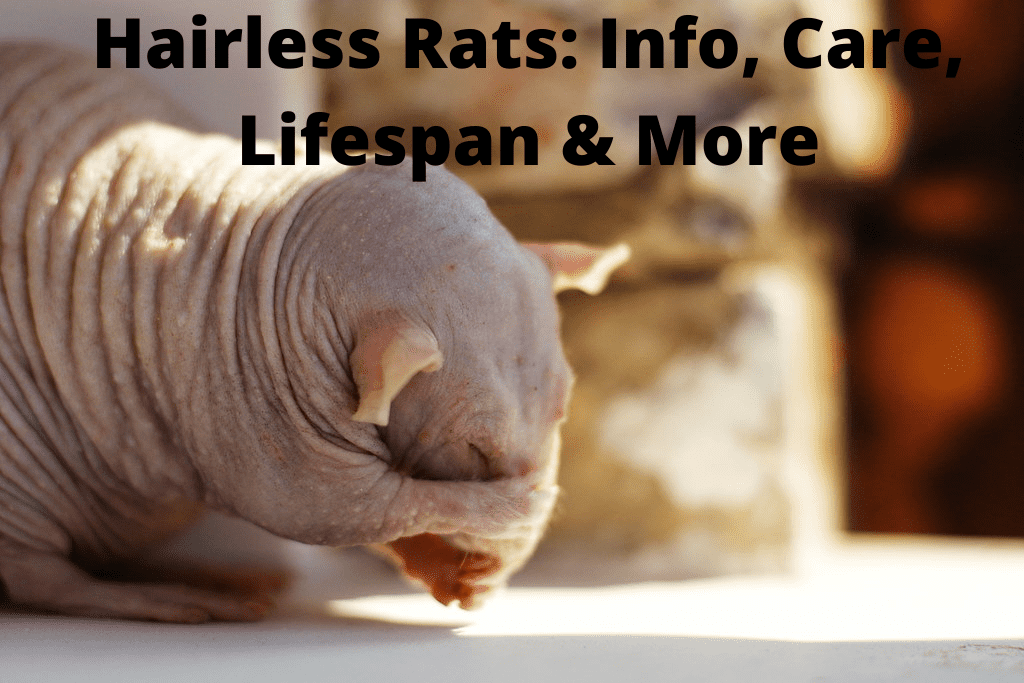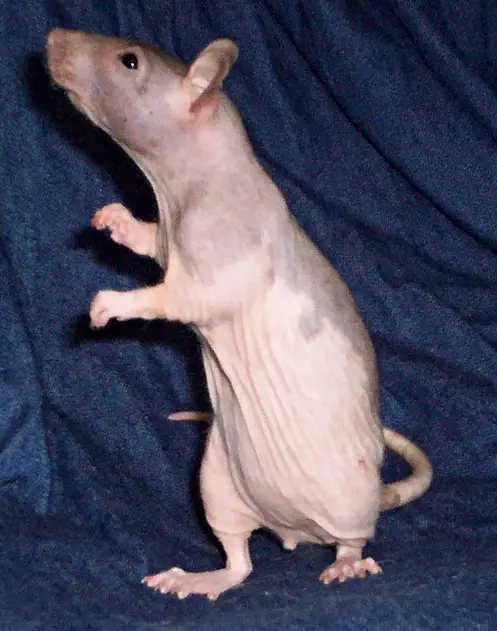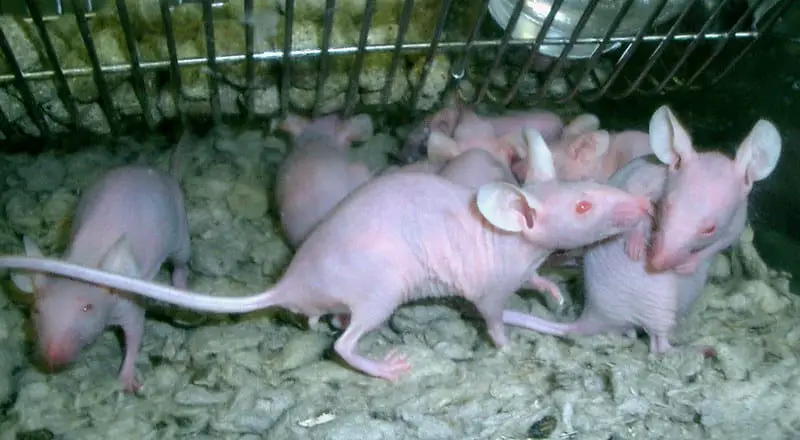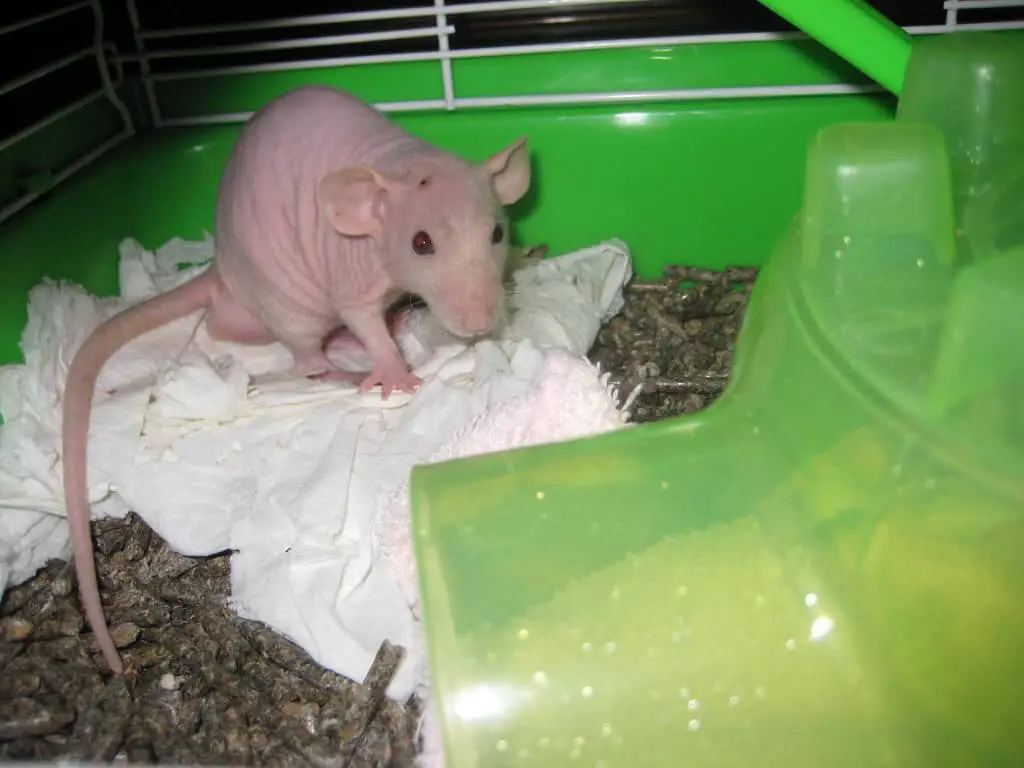Rats come in many different varieties. Most of the varieties are well known to people, but none of them are as mysterious and thought-provoking as the hairless rat. These rats are also known as Sphynx Rats. As the name suggests, this rat has no hair. They have no hair as a result of genetic mutation. The fact that they have no hair is easily their most defining characteristic and it is what they’re most known for. However, there’s much more to learn about these little critters than just that.

Today, we’re going to take a closer look at the hairless rat. We’ll discuss their origins, facts, how to care for them, and much more. That way, you’ll have the most complete overview possible of these interesting rodents.
Fact Sheet
| Name | Hairless Rat |
| Species | Rattus Norvegicus |
| Lifespan | On average 1 year |
| Experience required | Intermediate |
| Temperament | Affectionate, intelligent, energetic, docile, social |
| Minimum cage size | At least 30” x 15” x 20” for a pair of rats, but the bigger the better. |
| Diet | Omnivorous, 80% pellets, 20% fruits & vegetables supplemented with the occasional piece of meat, fish, or nut. |
| Price | $20 to $50 |
Are hairless rats a separate breed?
Many people are under the assumption that hairless rats are a distinct breed. It’s an easy mistake to make. After all, these rats do look very different from all other rats. Nevertheless, this is not the case. They are in fact not a distinct breed, they’re simply a variety of the Fancy Rat (Rattus Norvegicus).
There are 7 different types of rats, and this rat is one of them. Interestingly enough, the fact that it’s not a separate breed means that they can also have traits of the other rat types. For instance, hairless dumbo rats definitely exist. They have the characteristic traits from both variants, meaning that they do not have hair and also have dumbo ears!
Types of hairless rats
There are two different types of hairless rats: The True Hairless Rat, also known as the Sphynx rat, and the double Rex rat.
Double Rex rats are often not completely bald but do have bald spots. There is also the Patchwork variant of the double Rex, these rats lose and regrow hair on different patches of their body throughout their life.
The Truly Hairless Rat, also known as the Sphynx rat has no hair anywhere on its body. In addition, they do not have whiskers, something that double Rexes do have. This is the rat that people usually talk about when they refer to “hairless rats”.
An interesting fact about these rats is that even though they have no hair, they can still have markings. You can see these markings by the different levels of pigmentation on their skin.
Some examples of markings that they can have include:
- Hooded
- Masked
- Blaze
- Berkshire
- Irish
- Essex

Temperament of the hairless rat
- ✔️Affectionate
- ✔️ Smart
- ✔️ Intelligent
- ✔️ Clean
- ✔️ Social
Hairless rats are social animals. In the wild, they live in groups called “mischiefs”. In captivity, they retain these social characteristics and get along very well with humans and other rats.
Because they are so social, you must always make sure that if you decide to adopt rats that you always do so in pairs. Rats do not like to live alone and can get very lonely, which can result in undesirable behavior.
It is not necessary to adopt two bald rats, they get along with regular rats just fine! Sometimes they even prefer having furry cage mates because they’re warmer to cuddle up against.
In addition, rats are highly affectionate, intelligent, curious, and energetic. They love to play and can be taught many tricks. They can even learn how to solve puzzles and complex mazes. They’re among the smartest animals on the planet and are not afraid to show it.
In addition, while most people believe rats to be dirty, this is far from true. Rats spend a large part of their day grooming themselves and their friends. Because of this, they’re very clean animals.
On the whole, the temperament of these animals is ideal for a pet: smart, affectionate, energetic, intelligent, and clean.
Caring for hairless rats

Caring for hairless rats is in many ways quite similar to caring for regular rats. Nevertheless, there are some important differences and challenges that their lack of fur brings.
Diet 🥕
Rats are omnivores and can eat a large variety of different foods. Most rats are not picky eaters in the slightest and will eat almost anything that’s offered to them. However, it’s up to us as rat owners to ensure that they eat the food that benefits them the most. For a rat to thrive, they should have a diet that consists of 80% pellets, and 20% vegetables and fruits. In addition, they can also eat the occasional piece of meat, fish, nut, or dairy.
Here are some of the foods that they love to eat:
- Fruits: Apples, bananas, blueberries, strawberries, melons, apricots.
- Vegetables: Kale, carrots, bell peppers, endive, celery.
- Meat: Chicken, turkey, or low-fat beef.
- Nuts: Walnuts, cashews, pistachios (small quantities, unsalted)
- Others: Unsweetened yogurt, sunflower seeds, rice, a small piece of bread
Of course, while rats are omnivorous, there are certain foods that you have to avoid at all costs. Here are some of the most common foods that you should never give to a rat:
- ❌ Chocolate
- ❌ Onion
- ❌ Rhubarb
- ❌ Beets
- ❌ Green parts of tomatoes (leaf, stems)
- ❌ Dried corn
- ❌ Raw beans
An interesting fact about hairless rats is that they typically eat a bit more than their furry counterparts. The reason for this is that due to their lack of fur, they spend more energy keeping themselves warm. To compensate for that, they need to eat a bit more food.
The best way to learn about which foods to feed and which foods to avoid is by reading through my rat nutrition guide.
Housing 🏠
As previously mentioned, rats do not do well in solitude, they need a companion to socialize with in order to stay happy. Because of this, it’s important that you buy a cage that’s big enough for two rats. If you’re getting more than two rats, the cage size should increase to accommodate them and give each rat an appropriate amount of space.
The minimum cage size for two rats is 30 by 15 by 20 inches. Of course, if you can get a bigger cage, that’s always better. It’s almost impossible to buy too big of a cage.
An important thing to note when buying a rat cage is bar spacing. The bar spacing needs to be between 0.4 and 0.6 inches. This allows them to climb the cage while not allowing them to escape. Multi-level cages are also recommended. Rats enjoy climbing to high spaces, which a multi-level cage allows them to do.
Alternatively, some rat owners choose to house their rats in an empty, glass aquarium. They do this because the aquarium provides more warmth and cover. This is certainly an option, as long as you clean the tank frequently and make sure that it’s big enough.
Cage essentials
Of course, an empty cage is no place for a rat to live! They need the following essential components to thrive in their habitat:
- An exercise wheel. Allows your furry friend to unleash pent up energy.
- Food and water bowl/bottle. They need a place to eat and drink from!
- Houses and huts. Rats enjoy having time to themselves and some privacy. Houses and huts give them that luxury.
- Tunnels. Satisfies your rat’s urge to dig and burrow.
- Ladders. Rats enjoy climbing, ladders are a great way to allow them to do so.
- Bedding. Can be made out of shredded paper, fleece, or aspen wood shavings.
Grooming ✂️
Rats are really good at keeping themselves clean so they do not need much grooming from their owners. Especially hairless rats, courtesy of them having no hair, do not need a lot of grooming. They do not need to be bathed regularly. Only on special occasions when they’ve gotten themselves exceptionally dirty.
In those rare cases, don’t just dump your rat in the bathtub. Fill a small container with warm (not hot) water, cup some of the water in your hand and trickle it on your rat’s fur. You can also use some special rat shampoo if necessary.
Lifespan
On average, the lifespan for a hairless rat is about a year. This is notably shorter than that of other rat types who live an average of 2 years. The reason for this is that their immune system is not as good as that of regular fancy rats.
Concerns
While hairless rats can be good pets, there are a few concerns and challenges that you have to take into account.
Firstly, you have to make sure that you do not let them play in the sun. Rats are already quite vulnerable to the sun, but for rats that have no hair to protect their delicate skin, this is even more so the case. Make sure that you never place their cage in the sun and if you let them play outside of their cage make sure that you let them play in a shaded place away from the sun.
Secondly, since they are not protected by a layer of fur they’re more prone to scratches, scars, and irritations of the skin. Because of this, it’s very important that you keep their cage clean at all times.
Thirdly, the fact that they do not have a coat to keep them warm means that they get cold more easily. Make sure that you do not put their cage in a drafty place and that the temperature does not get too low. Rats prefer a temperature between 65 and 79 degrees Fahrenheit, so be on the higher end of that range with hairless rats.
Some people recommend heat lamps to keep them warm enough but this is usually not necessary as long as you can keep the temperature above 70 degrees Fahrenheit consistently.
Interestingly enough, some people also put sweaters on their rats to keep them warm. These sweaters can sort of act as a replacement for fur that normal rats have.
Hairless Rat Price

On average, expect to pay between $20 to $50 for a hairless rat. The price does depend on location, availability, pedigree, and the breeder you buy from, but this is a good estimate to shoot for.
These rats are available from pet shops and breeders. Pet shops do not have them available very often and it’s generally recommended to buy from breeders regardless. Breeders often take better care of the rats they sell and socialize them better. Camarattery.com is a good rat breeder that sells many different types of rats.
It’s important that you also budget for the maintenance costs of keeping a rat, which is usually around $50 per month.
Frequently asked questions
Are hairless rats born without hair?
No, they actually have hair when they are born. According to the Laboratory of Animal Sciences, they lose their hair between 3 and 5 weeks of age.
Do hairless rats have red eyes?
They usually do not have red eyes, but on occasion they do. This is because rats can be albino and hairless at the same time, which causes red eyes and bald skin.
Final words
Hairless rats are interesting animals that have a lot to offer. Their great temperament combined with their high intelligence and unique appearance makes them an exquisite pet as long as you take the right precautions while caring for them.
It is important that you know the differences between these rats and their furry counterparts so that you’re aware of the special care they require. If after learning all of this you’ve decided that a bald rat is a good fit for you, congratulations, and good luck with your new best friend!
- How Long Do American Eskimo Dogs Live? Important Factors and Care Tips - September 29, 2023
- Do American Bulldogs Need Grooming? Essential Tips and Care Guidelines - September 29, 2023
- Do Bengal Cats Enjoy Playing? Essential Tips for Keeping Them Active - September 29, 2023